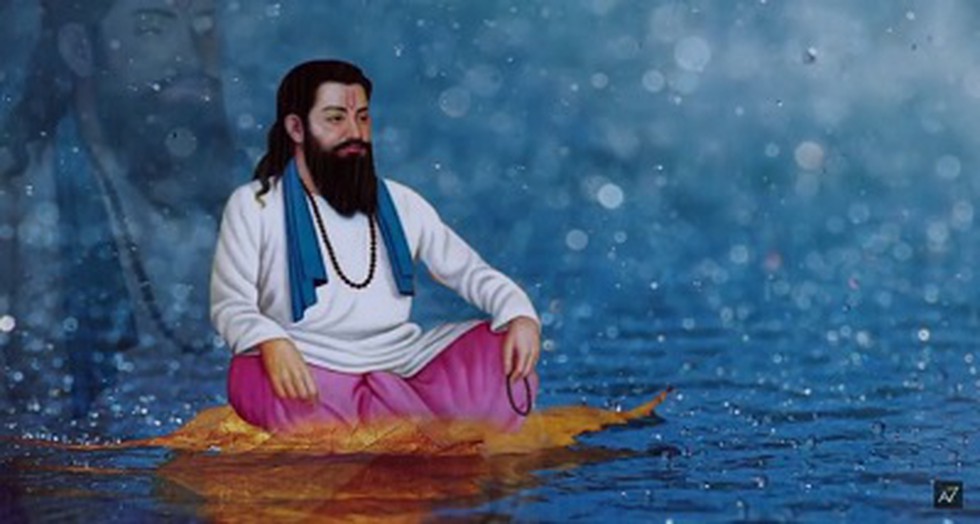
Bhakti Movement, Caste and Begumpura
“Forgotten is the pride of varna and of caste” – varnaabhimaan visarun yati — so sang Tukoba as he danced with his fellow sants on the river banks, celebrating equality. Garlanded with tulsi, they “fall at one another’s feet” rather than the “lower” falling at the feet of the socially “higher” people.
Equality and rejection of caste hierarchy was a major theme of the bhakti movement. Ravidas’ “Begumpura,” a song of a “city without sorrow,” speaks of there being neither one, two or three:
The regal realm with the sorrowless name:
they call it Begumpura, a place with no pain,
No taxes or cares, nor own property there,
no wrongdoing, worry, terror or torture.
Oh my brother, I’ve come to take it as my own,
my distant home, where everything is right.
That imperial kingdom is rich and secure,
where none are third or second—all are one;
Its food and drink are famous, and those who live there
dwell in satisfaction and in wealth.
They do this or that, they walk where they wish,
they stroll through fabled palaces unchallenged.
Oh, says Ravidas, a tanner now set free,
those who walk beside me are my friends.
Begumpura is also, it should be noted, a place of abundant food and drink: both poverty and inequality are rejected in this vision of an earthly utopia.
Kabir was equally equalitarian and scornful of those who advocated caste hierarchy. He was explicitly anti-brahmanical:
Worship, libations, six sacred rites,
this dharma’s full of ritual blights.
Four ages teaching Gayatri, I ask you, who won liberty?
You wash your body if you touch another,
tell me who could be lower than you?
Proud of your merit, puffed up with your rights,
no good comes out of such great pride
How could he whose very name
is pride-destroyer endure the same?
Drop the limits of caste and clan,
seek for freedom’s space,
destroy the shoot, destroy the seed,
seek the unembodied place. (Ramaini 35)
Bhakti was full of aspiration for the divine, and along with this it affirmed the universality of love of equality among human beings. This was its great contribution.
In the 18th century, with hagiographers like Priyadas in north India and Mahipati in Maharashtra, a process began of cooptation. These writers interpreted bhakti in a brahmanical fashion, for instance showing Ravidas as being born as a Chamar due to the “sin” of having fed meat to a Brahman guru in a previous birth, and with this rejecting the milk of his “untouchable” mother! This was in opposition to Tuka’s view of Ravidas as having a pure caste and lineage: “He’s a devotionless Brahman, let his face burn, from what concubine was he born? Blessed is the mother of the Vaishnava Chambhar, both caste and lineage are pure….” But because of the cooptation, the equalitarianism inherent in bhakti was weakened and almost lost. Nevertheless, it has left an important heritage of aspiration and equality.
Author – Gail Omvedt, article was published originally under the name “Bhakti and Caste” on author’s blog, Seeking Begumpura.
—
Gail Omvedt in her book, Seeking Begumpura, writes “It (begumpura poem) was an expression, in the early modern age, of a utopia, perhaps the first one in Indian literature. In some ways, it seems to stand alone, yet it was a harbinger -of the kind of social vision that would underlie all the later struggles and theorizing of anticaste intellectuals. Begumpura was, for Ravidas, an imagined city, without geographical location, without a history: it was to be a later task to build it in space and time.”



We all Bhahujan would be remained obliged of the VELIVADA Publication who offering The Great Bahujan Mahapurush’s literature on easy platform. We shall also be very grateful if we get these literatures in language HINDI including the Sat Guru Ravidass ji Maharaj.
We will try to bring content in other languages in future on Velivada website.
Thank you for your support.